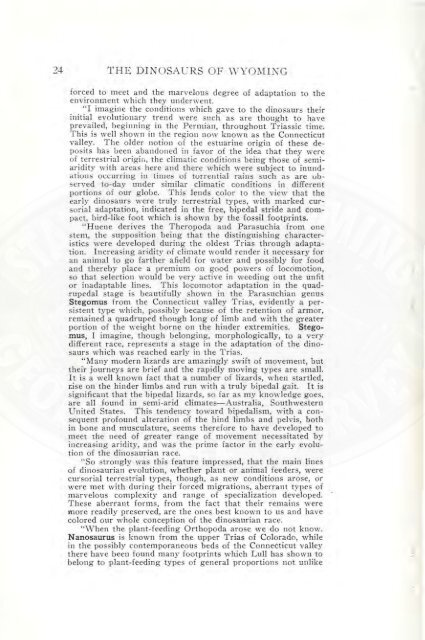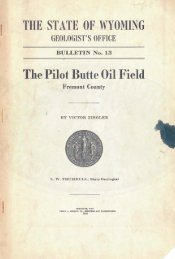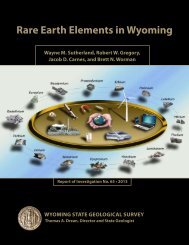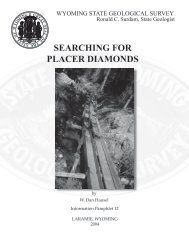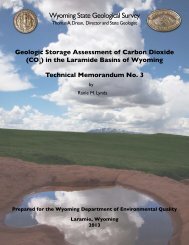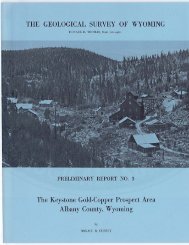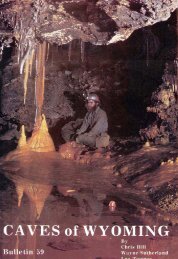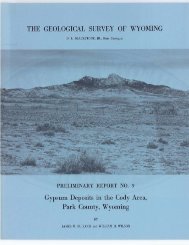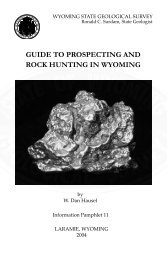The Dinosaurs of Wyoming - Wyoming State Geological Survey ...
The Dinosaurs of Wyoming - Wyoming State Geological Survey ...
The Dinosaurs of Wyoming - Wyoming State Geological Survey ...
Create successful ePaper yourself
Turn your PDF publications into a flip-book with our unique Google optimized e-Paper software.
24 THE DI OSADRS OF WYOMING<br />
forced to meet and the marvelous degree <strong>of</strong> adaptation to the<br />
environment which they underwent.<br />
"I imagine the conditions which gave to the dinosaurs their<br />
initial evolutionary trend were such as are thought to have<br />
prevailed, beginning in the Permian, throughout Triassic time:<br />
This is well shown in the region now known as the Connecticut<br />
valley. <strong>The</strong> older notion <strong>of</strong> the estuarine origin <strong>of</strong> these deposits<br />
has been abandoned in favor <strong>of</strong> the idea that they were<br />
<strong>of</strong> terrestrial origirl, the climatic conditions being those <strong>of</strong> semiaridity<br />
with areas here and there which were subject to inundations<br />
occurring in times <strong>of</strong> torrential rains such as are observed<br />
t.o-day under similar climatic conditions in different<br />
port.ions <strong>of</strong> our globe. This lends color to t.he view that the<br />
early dinosaurs were truly terrest.rial types, with marked cursorial<br />
adaptation, indicated in the free, bipedal stride and compact,<br />
bird-like foot. which is shown by the fossil footprints.<br />
"Ruene derives the <strong>The</strong>ropoda and Parasuchia from one<br />
st.em, the supposit.ion being that the distinguishing charact.erist.ics<br />
were developed during the oldest. Trias through adaptation.<br />
Increasing aridity <strong>of</strong> climate would render it. necessary for<br />
an animal to go farther afield for wat.er and possibly for food<br />
and thereby place a premium on good powers <strong>of</strong> locomotion,<br />
so that selection would be very act.ive in weeding out t.he unfit<br />
or inadaptable lines. This locomotor adaptation in the quadrupedal<br />
stage is beautifully shown in the Parasuchian genus<br />
Stegomus from the Connecticut valley Trias, evidently a persistent<br />
type which, possibly because <strong>of</strong> the retention <strong>of</strong> armor,<br />
remained a quadruped though long <strong>of</strong> limb and with t.he great.er<br />
portion <strong>of</strong> the weight borne on the hinder extremities. Stegomus,<br />
I imagine, t.hough belonging, morphologically, to a very<br />
different. race, represents a st.age in the adapt.ation <strong>of</strong> the dinosaurs<br />
which was reached early in the Trias.<br />
"Many modern lizards are amazingly swift <strong>of</strong> movement., but<br />
their journeys are brief and the rapidly moving types are small.<br />
It. is a well known fact that a number <strong>of</strong> lizards, when st.art.led,<br />
r.ise on t.he hinder limbs and run with a t.ruly bipedal gait. It is<br />
significant t.hat t.he bipedal lizards, so far as my knowledge goes,<br />
are all found in semi-arid climates-Aust.ralia, Southwestern<br />
United <strong>State</strong>s. This tendency t.oward bipedalism, with a conseQuent<br />
pr<strong>of</strong>ound alteration <strong>of</strong> the hind limbs and pelvis, both<br />
in bone and musculature, seems therefore to have developed to<br />
meet the need <strong>of</strong> greater range <strong>of</strong> movement necessit.ated by<br />
increasing aridity, and was t.he prime factor in the early evolution<br />
<strong>of</strong> the dinosaurian race.<br />
"So strongly \-vas t.his feature impressed, that the main lines<br />
<strong>of</strong> dinosaurian evolution, whet.her plant or animal feeders, were<br />
cursorial terrest.rial types, though, as new conditions arose, or<br />
were met with during their forced migrations, aberrant. types <strong>of</strong><br />
marvelous complexity and range <strong>of</strong> specialization developed.<br />
<strong>The</strong>se aberrant forms, from the fact that t.heir remains were<br />
more readily preserved, are the ones best known to us and have<br />
colored our whole conception <strong>of</strong> the dinosaurian race.<br />
"When the plant-feeding Orthopoda arose we do not know.<br />
Nanosaurus is known from the upper Trias <strong>of</strong> Colorado, while<br />
in the possibly contemporaneous beds <strong>of</strong> the Connecticut valley<br />
there have been found many footprints which Lull has shown to<br />
belong to plant-feeding types <strong>of</strong> general proportions not unlike<br />
-'


